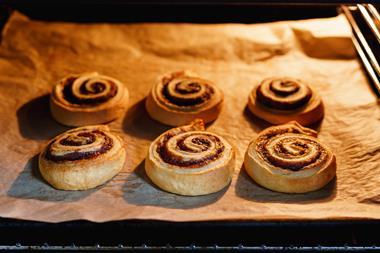As one holiday season passes and another begins, Gerhard Jenne reflects on the pits and peaks of Halloween, and looks to Christmas recipes.
Guy Fawkes Day marks the end of our autumn season. This Halloween, we focused more on our own baking for Halloween rather than buying in additional chocolates. Fittingly, we had made the decision to axe a few lines too. This meant there was less pressure on the shops to package relatively low-margin confectionery items and our production managed output very smoothly over the month of October. But what impact did this have on the sales?
From a first glance at the figures, it appears we sold about 20% less Halloween products. This does seem a little disappointing. I reckon about half of it is down to the fact that we cut back on the confectionery range and we had also made the decision earlier in the year to join ‘Camp Cake’ rather than keep a foot in ‘Camp Cupcake’. As seasonal campaigns go, cupcakes were at their most popular during Halloween. We had some fab decorations on them too; spiders, maggots, brains, eyeballs – it was always a tough act to follow.
We did very well with our Mini Bakes and voodoo gingerbread figures, but our theme was perhaps orientated towards adults a little bit too much when in fact most Halloween treats are bought for children. So next year, a bit less blood and gore and a bit more cutesy pumpkins and ghosts please!
But was it just tricks or were there treats too? As it turns out, the month of October wasn’t a horror at all – it turned out to be rather good in other ways. Because we had less confectionery to display, we were able to give more space to our regular products such as brownies, Mini Bakes and whole cakes. As a result, we saw a massive sales increase of up to 50% in those ranges, which, being higher-margin lines, meant it was treats for the bottom line last month.
While our theme was ‘Bloody Delicious’, it was bloody difficult to convince me to take the scythe to the beloved pumpkin cheesecake or white chocolate skull of years gone by. But I’m the first to admit there’s a lesson to be learned here: give more space to already popular lines and worry less about pretty but slow-selling shelf-fillers, or ‘dogs’ as they are called in management speak. Meanwhile, my management team will be reeling with horror when they see me dispensing these wise words after all the battles they had with me!
How soothing it is after all of this to get some kitchen time and bake our first Christmas Stollen. This traditional yeast-leavened bake is very much associated with the town of Dresden in Germany, but can only be called Dresdener Stollen if baked in the town of origin. It first gets a mention in the 14th century, but since then, has evolved from a dull fasting-time bread to the buttery, spiced and rich-in-fruit recipe it is today. In fact, a good Stollen has at least 60 parts of fruit, such as currants, raisins and peel, to 100 parts of flour, and should contain 30 parts of butter too, making it richer than a panettone or brioche. Some Stollen contain just raisins or a poppy seed filling, while others, such as the Konditor & Cook version, contains a mix of fruit and nuts and a strand of almond paste to give it extra moisture. In the UK, bakers have been more liberal with the recipes and added cranberries, or keep the bakes so moist it’s more of a cake then enriched bread.
Traditionally it is long, folded shape, with the top fold slightly short of the bottom and baked openly on trays, but it can also be baked fully enclosed, in a hinged Stollen tin to give it a uniform shape. After baking, it is preserved by dipping or brushing it in butter and rolling it in caster sugar. Once cooled, it is dusted with icing sugar. Folklore says that Stollen resemble Jesus wrapped in his swaddling clothes. Quite fittingly, we bake ours in little Moses baskets or wooden panibois moulds. As the spices waft through the air, the winter baking season has opened.
konditorandcook.com





























No comments yet